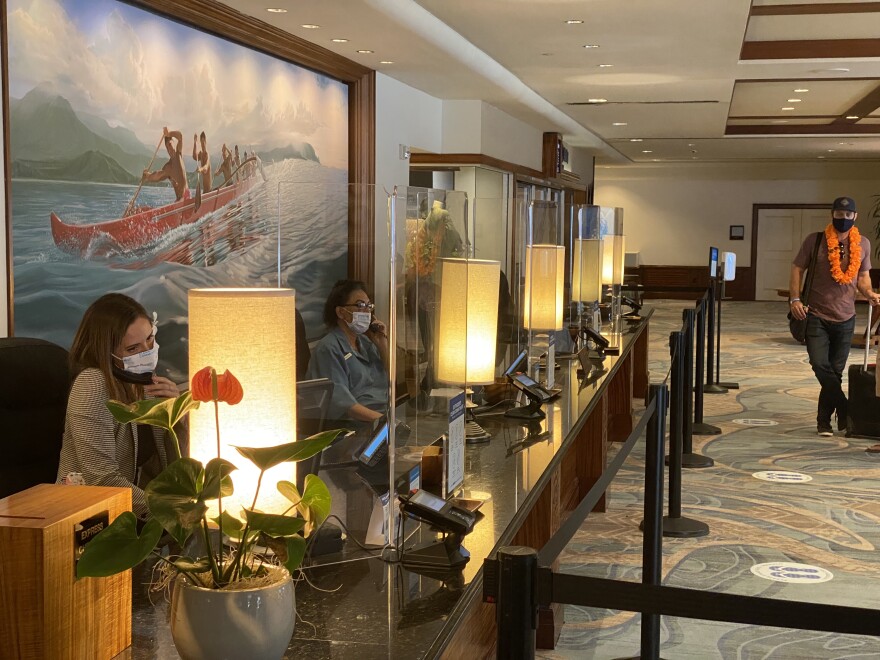Along with the rest of Hawaiʻi, Waikīkī has seen domestic tourism bounce back faster than many expected. This summer, Hawaiʻi Public Radio brings you a closer look at all things Waikīkī, but not just the tourism numbers.
Future of Waikīkī Beaches May Rely on $12M Shoreline Stabilization Project by Kuʻuwehi Hiraishi

Waikīkī’s iconic beaches may be getting a $12 million facelift as part of the state’s effort to increase the shoreline’s resilience to climate change, coastal erosion, and sea level rise.
After decades of piecemeal solutions, the Waikīkī Beach Improvement and Maintenance Program offers a long-range plan to stabilize the shoreline from Fort DeRussy to Kūhiō Beach.
Waikīkī Hotels Getting Back to Normal, But Obstacles Remain by Casey Harlow
The state's tourism has seen the pendulum swing from a record-high 10 million visitors in 2019 to record lows due to strict travel restrictions caused by the COVID-19 pandemic. Now, as visitors have returned, here's a look at how hotels are faring.
The Hawaiʻi Tourism Authority last week reported hotels in June saw a 77% occupancy rate, which is down 7% from the same time in 2019. Hotels across the state are cashing in to make up for the lower occupancy.
A Summer in Wakīkī With No Japanese Tourists by Zoe Dym
The pandemic has slowed the flow of Japanese travelers to Hawaiʻi to a trickle. That’s hit the hospitality industry around the state, but one of the areas seeing the most changes is Waikīkī.
The number of Japanese visitors decreased by nearly 80% last year compared to 2019, according to the Hawaiʻi Tourism Authority. They have not returned during the recent spring and summer months where the state saw a bigger number of domestic tourists than pre-pandemic times.

Staffing Remains a Big Concern for Waikīkī Hotels and Hospitality Union by Casey Harlow
As hotel occupancy rates continue to rise in the state, there is a staffing shortage in hotels and restaurants. While hotels are working to bring back employees, a local union is concerned they are using this time to cut jobs.
In 2019, more than 10 million visitors came to the state, spending nearly $18 billion. Of that, $7.65 billion was spent on lodging — accounting for nearly 43% of total visitor spending that year.
Waikīkī Restaurants Still Face Challenges Despite Crowds of Visitors and Locals by Casey Harlow
The hotel and restaurant industries were the most impacted during the COVID-19 pandemic. Although hotels are recovering due to the return of tourism, eateries are still having a difficult time.
Even in good times, successful restaurants in Hawaiʻi operate on very lean profit margins. This is due to the usual challenges that eateries face — rent, food costs, utilities, and labor.
Waikiki Surf and One Legendary Ride by Noe Tanigawa

Summertime means surf on the south shores of the Hawaiian Islands. On Oʻahu, that means in Waikiki, where chest-high waves out there now should gradually wane this week.
As part of our continuing series “Waikiki Summer,” HPR’s Noe Tanigawa talked with a local waterman who knows those surf breaks well — along with some of the stories behind them.

Aloha Friday Conversation: Stories from Waikīkī by Noe Tanigawa
On the Aloha Friday Conversation, HPR's Noe Tanigawa was joined by surf historian John Clark and acclaimed local musician Robert Cazimero for stories about the special magic of Waikīkī.
From Waikiki to Hawaiʻi Tourism Authority, John De Fries Shares Core Hawaiian Values by Catherine Cruz and HPR News Staff

John De Fries, the first Native Hawaiian to head the Hawaiʻi Tourism Authority, fondly remembers growing up on the Diamond Head side of Waikiki surrounded by family and friends.
Because of his upbringing in Waikiki, there were hopes he could bring a sensitivity to the HTA post. The Conversation met with De Fries at the end of a tiny Waikiki street that some years ago he called home. He shared his visions for Hawaiʻi tourism during what may be the industry's most challenging period.
Keep checking back for more installments of HPR's Waikīkī Summer series.




